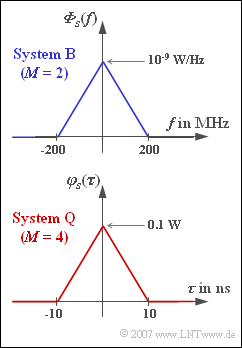Exercise 2.3: Binary Signal and Quaternary Signal
Two redundancy-free transmission systems $\rm B$ and $\rm Q$ each with bipolar amplitude coefficients $a_{\nu}$ are to be compared. Both systems satisfy the first Nyquist condition. According to the root-root splitting, the spectrum $G_{d}(f)$ of the basic detection pulse is equal in shape to the power-spectral density ${\it \Phi}_{s}(f)$ of the transmitted signal.
The following properties of the two systems are known:
- From the binary system $\rm B$, the power-spectral density ${\it \Phi}_{s}(f)$ at the transmitter is known and shown in the graph together with the description parameters.
- The quaternary system $\rm Q$ uses a NRZ rectangular signal with the four possible amplitude values $±s_{0}$ and $±s_{0}/3$, all with equal probability.
- ${s_{0}}^{2}$ indicates the maximum instantaneous power that occurs only when one of the two "outer symbols" is transmitted. The descriptive parameters of system $\rm Q$ can be obtained from the triangular ACF in the adjacent graph.
Notes:
- The exercise is part of the chapter "Basics of Coded Transmission".
- Reference is also made to the chapter "Redundancy-Free Coding".
- Consider that auto-correlation function $\rm (ACF)$ and power-spectral density $\rm (PSD)$ of a stochastic signal are always related via the Fourier transform.
Questions
Solution
- $$f_{\rm Nyq} = \frac{1 } {2 \cdot T} \hspace{0.3cm}\Rightarrow \hspace{0.3cm} T = \frac{1 } {2 \cdot f_{\rm Nyq}} \hspace{0.15cm}\underline{ =5\,{\rm ns}}\hspace{0.05cm}.$$
(2) In the binary system, the bit rate is also the information flow and it holds:
- $$R_{\rm B} = {1 }/ { T} \hspace{0.15cm}\underline {= 200\,{\rm Mbit/s}}= 2 \cdot f_{\rm Nyq} \cdot{\rm bit}/{\rm Hz}\hspace{0.05cm}.$$
(3) The transmitted power is equal to the integral over ${\it \Phi}_{s}(f)$ and can be calculated as a triangular area:
- $$P_{\rm S} = \ \int_{-\infty}^{+\infty} {\it \Phi}_s(f) \,{\rm d} f = 10^{-9} \frac{\rm W}{\rm Hz} \cdot 200\,\,{\rm MHz} \hspace{0.15cm}\underline { = 200\,\,{\rm mW}}.$$
(4) The first two statements are correct:
- The Fourier inverse transform of the power-spectral density ${\it \Phi}_{s}(f)$ gives the $\rm sinc^{2}$–shaped ACF $\varphi_{s}(\tau)$. In general, the following relationship also holds:
- $$ \varphi_s(\tau) = \sum_{\lambda = -\infty}^{+\infty}{1}/{T} \cdot \varphi_a(\lambda)\cdot \varphi^{^{\bullet}}_{gs}(\tau - \lambda \cdot T)\hspace{0.05cm}.$$
- However, for a redundancy-free binary system, $\varphi_{a}(\lambda = 0) = 1$, while all other discrete ACF values $\varphi_{a}(\lambda \neq 0)$ are equal to $0$. Thus, the energy ACF also has a $\rm sinc^{2}$–shaped curve (note: energy ACF and energy PSD are each dotted in this tutorial):
- $$\varphi^{^{\bullet}}_{gs}(\tau ) = T \cdot \varphi_s(\tau) \hspace{0.05cm}.$$
- The last statement is not true. For the following reasoning, we assume for simplicity that $g_{s}(t)$ is symmetric and thus $G_{s}(f)$ is real. Then holds:
- $${\it \Phi}_{s}(f) = {1 }/ { T} \cdot |G_s(f)|^2\hspace{0.3cm}\Rightarrow \hspace{0.3cm}G_s(f) = \sqrt{{ T} \cdot {\it \Phi}_{s}(f)}\hspace{0.4cm} \bullet\!\!-\!\!\!-\!\!\!-\!\!\circ \hspace{0.4cm}g_s(t) \hspace{0.05cm}.$$
- Due to the square root in the above equation, the basic transmission pulse $g_{s}(t)$ is not $\rm sinc^{2}$–shaped in contrast to the basic detection pulse $g_{d}(t)$, which is equal in shape to the energy ACF $\varphi^{^{\bullet}}_{gs}(\tau)$ and thus $\rm sinc^{2}$–shaped. At the same time, $\varphi^{^{\bullet}}_{gs}(\tau) = g_{s}(\tau) ∗ g_{s}(–\tau)$ holds.
(5) The ACF $\varphi_{s}(\tau)$ is limited to the range $|\tau| ≤ T$ when the basic transmission pulse is an NRZ rectangle. From the graph, the symbol duration $T \underline{= 10 \ \rm ns}$.
(6) For the quaternary signal, the information flow is the same as for the binary signal above because of the double symbol duration:
- $$R_{\rm B} = {{\rm log_2(4)} }/ { T} \hspace{0.15cm}\underline {= 200\,\,{\rm Mbit/s}}\hspace{0.05cm}.$$
(7) The transmitted power is equal to the ACF value at $\tau = 0$ and can be read from the graph:
- $$P_{\rm S} = \hspace{0.15cm}\underline {100\,\,{\rm mW}}.$$
(8) For the redundancy-free quaternary signal with NRZ rectangular pulses, the average transmitted power is:
- $$P_{\rm S} = {1}/ { 4} \cdot \left [ (-s_0)^2 + (-s_0/3)^2 + (+s_0/3)^2 +(+s_0)^2 \right ] = {5}/ { 9} \cdot s_0^2$$
- $$\Rightarrow \hspace{0.3cm}s_0^2 = {9}/ {5} \cdot P_{\rm S} = {9}/ {5} \cdot 100\,\,{\rm mW}\hspace{0.15cm}\underline { = 180\,\,{\rm mW}}\hspace{0.05cm}.$$
